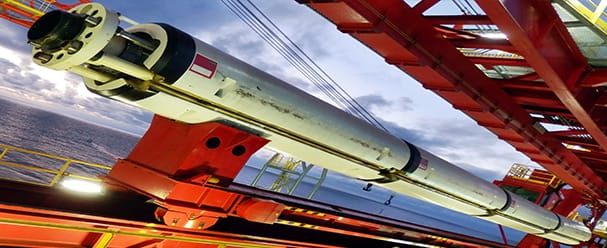Riser Systems Engineering

When a floating host is connected to a wellhead, pipeline, or flowline on the seafloor with a fluid-carrying pipe (i.e., a riser), issues of containing pressure in a highly dynamic environment are unavoidably posed and must be addressed through:
- Global and coupled riser analysis for strength and fatigue life
- Sizing of components
- Component design load definition
- Detailed design, analysis, and testing of components
- Materials selection
- Fitness-for-service evaluation
- Engineering Criticality Assessment (ECA)
- Equipment and component specification
- Welding procedure development and selection
Since 1975, Stress Engineering Services has been providing quality riser design and analysis services to clients around the world. Our extensive structural, mechanical, and materials experience, in combination with our proprietary in-house riser analysis tools, allows us to fully address complex riser design and analysis issues and deliver the most effective solutions within our clients’ scheduling constraints.
Our renowned expertise centers on the design and analysis of production, drilling, combo (combined production and drilling), export, water-injection, and completion riser systems. We have design experience with a variety of riser configurations, including top-tensioned risers (TTRs), flexibles, hybrid risers, steel catenary risers (SCRs), steel lazy-wave risers, as well as a variety of other less mature concepts.
Production, Water Injection, and Export Risers
Production and export risers are typically deployed for 20 years or more. They are therefore exposed to a high risk of very extreme environmental conditions as well as smaller-amplitude daily loading over a very long period of time. These extreme and fatigue-damage causing loads (together with potentially high pressure and temperature for production risers) must be accommodated by the riser systems’ components, including tensioners and hang-off structures. Top-tensioned production risers consist of a set of tubes, one inside another, which contributes additional complexity to the engineering of these systems. Understanding how to address the composite action of the multiple tubes under dynamic loading is an important aspect of top-tensioned production riser analysis.
Drilling Riser Configuration Optimization
We specialize in determining the best riser assembly for a given rig, mud weight, water depth, sea state, current, tensioner system, hook load limit, and riser joint inventory. Our focus is to assure that the riser system and floating host vessel stay within proper load and motion limits and that the riser system is capable of safely enduring any fatigue or corrosion damage that may occur.
Drilling and Completion Risers Operating Limits
Risers used to drill and complete wells in deep- and ultra-deep water are typically deployed from MODUs (mobile offshore drilling units) or drill ships. Each of these host vessels has its own particular set of characteristics that affect the loading on the drilling riser and the subsea wellhead to which it is connected. While these risers are not deployed for long periods of time, their deployment poses unique risks to the well and to the environment. We perform a variety of analyses to determine safe operating envelopes that drilling and completion operations must remain within, including:
- Weak Point Analysis
- Operability Envelope Analysis
- Riser Recoil Analysis
- Drilling Riser Tensioner Analysis
- Wave Fatigue Analysis
- Hang-off and Deployment Analysis
Our Capabilities
At Stress Engineering Services, we offer the following engineering solutions:



